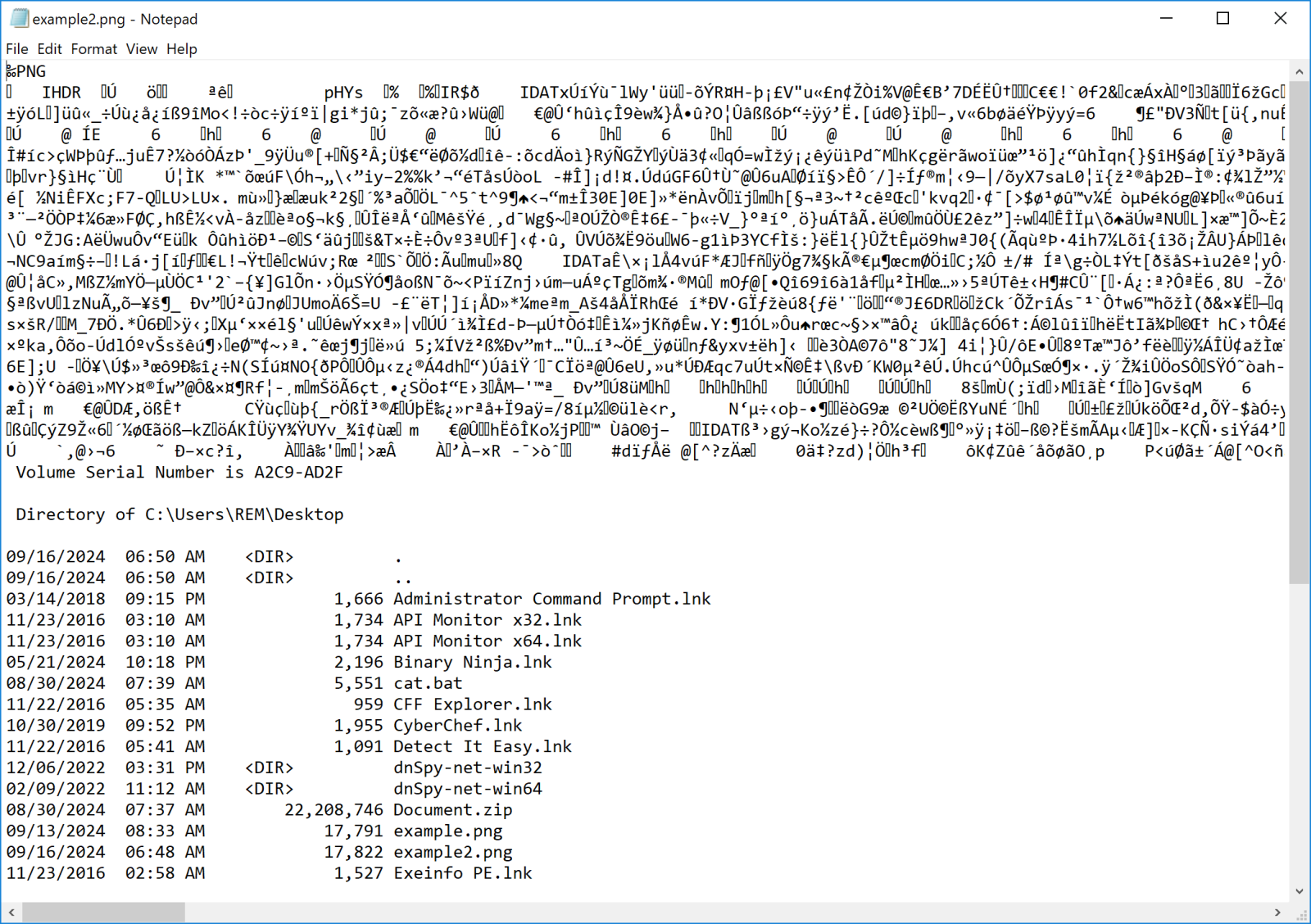Managing PE Files With Overlays, (Mon, Sep 16th)
SANS Internet Storm Center, InfoCON: green 2024-09-16
There is a common technique used by attackers: They append some data at the end of files (this is called an overlay). This can be used for two main reasons: To hide the appended data from the operating system (steganography). By example, you can append a text file at the end of a JPEG image. When your favourite image viewer will process the picture, it will just ignore the "rogue" data. Here is a PNG picture that has a text file (dir output) added at the end:
The second reason is to defeat security controls and tools by creating a very big file. For performance reasons, many tools won't scan or inspect big files. So attackers will append data to increase the file size. Usually, data are just a suite of zeroes because the compression ration is excellent. Here is recent example of files that I discovered:
remnux@remnux:/MalwareZoo/20240910$ file 'Payment Confirmation.tgz'Payment Confirmation.tgz: gzip compressed data, last modified: Tue Sep 10 06:05:16 2024, from FAT filesystem (MS-DOS, OS/2, NT), original size modulo 2^32 750001664 gzip compressed data, unknown method, ASCII, extra field, has comment, from FAT filesystem (MS-DOS, OS/2, NT), original size modulo 2^32 750001664remnux@remnux:/MalwareZoo/20240910$ ls -l 'Payment Confirmation.tgz'-rwx------ 1 remnux remnux 1167212 Sep 10 03:11 'Payment Confirmation.tgz'
The file is 1.1MB in size but it contains a pretty big executable (less common):
remnux@remnux:/MalwareZoo/20240910$ tar tzvf 'Payment Confirmation.tgz'-rwxr-xr-x 0/0 750000000 2024-09-10 02:04 Payment Confirmation.exe
If you unpack and inspect the file manually, you'll see that it contains indeed a huge amount of NULL bytes:
remnux@remnux:/MalwareZoo/20240910$ xxd 'Payment Confirmation.exe'...00093fa0: 0000 0000 0000 0000 0000 0000 0000 0000 ................00093fb0: 0000 0000 0000 0000 0000 0000 0000 0000 ................00093fc0: 0000 0000 0000 0000 0000 0000 0000 0000 ................00093fd0: 0000 0000 0000 0000 0000 0000 0000 0000 ................00093fe0: 0000 0000 0000 0000 0000 0000 0000 0000 ................00093ff0: 0000 0000 0000 0000 0000 0000 0000 0000 ................00094000: 0000 0000 0000 0000 0000 0000 0000 0000 ................00094010: 0000 0000 0000 0000 0000 0000 0000 0000 ................00094020: 0000 0000 0000 0000 0000 0000 0000 0000 ................00094030: 0000 0000 0000 0000 0000 0000 0000 0000 ................00094040: 0000 0000 0000 0000 0000 0000 0000 0000 ................00094050: 0000 0000 0000 0000 0000 0000 0000 0000 ................00094060: 0000 0000 0000 0000 0000 0000 0000 0000 ................00094070: 0000 0000 0000 0000 0000 0000 0000 0000 ................00094080: 0000 0000 0000 0000 0000 0000 0000 0000 ................00094090: 0000 0000 0000 0000 0000 0000 0000 0000 ................000940a0: 0000 0000 0000 0000 0000 0000 0000 0000 ................000940b0: 0000 0000 0000 0000 0000 0000 0000 0000 ................000940c0: 0000 0000 0000 0000 0000 0000 0000 0000 ................000940d0: 0000 0000 0000 0000 0000 0000 0000 0000 ................000940e0: 0000 0000 0000 0000 0000 0000 0000 0000 ................000940f0: 0000 0000 0000 0000 0000 0000 0000 0000 ................00094100: 0000 0000 0000 0000 0000 0000 0000 0000 ................00094110: 0000 0000 0000 0000 0000 0000 0000 0000 ................00094120: 0000 0000 0000 0000 0000 0000 0000 0000 ................00094130: 0000 0000 0000 0000 0000 0000 0000 0000 ................00094140: 0000 0000 0000 0000 0000 0000 0000 0000 ................00094150: 0000 0000 0000 0000 0000 0000 0000 0000 ................00094160: 0000 0000 0000 0000 0000 0000 0000 0000 ................00094170: 0000 0000 0000 0000 0000 0000 0000 0000 ................00094180: 0000 0000 0000 0000 0000 0000 0000 0000 ................00094190: 0000 0000 0000 0000 0000 0000 0000 0000 ................000941a0: 0000 0000 0000 0000 0000 0000 0000 0000 ................000941b0: 0000 0000 0000 0000 0000 0000 0000 0000 ................000941c0: 0000 0000 0000 0000 0000 0000 0000 0000 ................000941d0: 0000 0000 0000 0000 0000 0000 0000 0000 ................000941e0: 0000 0000 0000 0000 0000 0000 0000 0000 ................000941f0: 0000 0000 0000 0000 0000 0000 0000 0000 ................00094200: 0000 0000 0000 0000 0000 0000 0000 0000 ................00094210: 0000 0000 0000 0000 0000 0000 0000 0000 ................00094220: 0000 0000 0000 0000 0000 0000 0000 0000 ................00094230: 0000 0000 0000 0000 0000 0000 0000 0000 ................00094240: 0000 0000 0000 0000 0000 0000 0000 0000 ................00094250: 0000 0000 0000 0000 0000 0000 0000 0000 ................00094260: 0000 0000 0000 0000 0000 0000 0000 0000 ................00094270: 0000 0000 0000 0000 0000 0000 0000 0000 ................00094280: 0000 0000 0000 0000 0000 0000 0000 0000 ................
From a Windows loader point of view, this is not an issue: it will just ignore all the bytes that are not interesting to execute the process. Thank you Microsoft!
How can you analyze the PE file without being annoyed by the overlay? Just remove it! If you can try to manipulate the file with your favourite text editor, there is an easy way to perform this task in a few lines of Python. A classic PE files looks like this (in a very simple way!):

In the PE headers, you can find a list of all the sections present in the file with two parameters:
- The section offset (PointerToRawData)
- The section size (SizeOfRawData)
It's easy to get the overlay offset: PointerToRawData + SizeOfRawData. This value should be the end of the file. If the file size on disk is bigger, we have an overlay!
Python has a great module called pefile[1] that helps to investigate executables. I wrote a small script to remove an overlay from a PE file:
#!/usr/bin/python3## Detects if a PE file has an overlay.# If yes, it creates a new PE file without the extra data.#import osimport sysimport pefiledef detect_overlay(pe_filename): ''' Detects and removes overlay from a PE file ''' try: pe = pefile.PE(pe_filename) except Exception as e: print(f"Can't open the PE file: {e}") return # Display sections print(f"{'Section Name':<15} {'Virtual Size':<15} {'Raw Size':<15} {'Raw Offset':<15}") print("="*58) for s in pe.sections: s_name = s.Name.decode('utf-8').rstrip('\x00') virtual_size = s.Misc_VirtualSize raw_size = s.SizeOfRawData raw_offset = s.PointerToRawData print(f"{s_name:<15} {virtual_size:<15} {raw_size:<15} {raw_offset:<15}") # The offset at which the PE sections end last_section = pe.sections[-1] end_of_pe = last_section.PointerToRawData + last_section.SizeOfRawData # The actual file size file_size = os.path.getsize(pe_filename) if file_size > end_of_pe: overlay_size = file_size - end_of_pe print(f"Overlay detected: {overlay_size} bytes") try: with open(pe_filename, 'rb') as infile: data = infile.read(end_of_pe) except Exception as e: print(f"Can't open {pe_filename}: {e}") return name, ext = os.path.splitext(pe_filename) new_pe_filename = f"{name}-clean{ext}" try: with open(new_pe_filename + "", 'wb') as outfile: outfile.write(data) except Exception as e: print(f"Can't write {new_pe_filename}: {e}") return new_file_size = os.path.getsize(new_pe_filename) print(f"New PE dumped: {new_pe_filename} (Size: {new_file_size})") else: print("No overlay detected")if __name__ == "__main__": if len(sys.argv) != 2: print("Usage: python3 overlay.py <pefilename>") sys.exit(1) detect_overlay(sys.argv[1])Let's process our big PE file:
remnux@remnux:/MalwareZoo/20240910$ python3 overlay.py Payment-Confirmation.exeSection Name Virtual Size Raw Size Raw Offset ==========================================================.text 587568 587776 512 .rsrc 1580 2048 588288 .reloc 12 512 590336 Overlay detected: 749409152 bytesNew PE dumped: Payment-Confirmation-clean.exe (Size: 590848)
Now, you can investigate the new sample as usual...
Be careful with overlays! Most of the time, they are just NULL bytes but they may contain useful data that will be used by the malware at execution time (configuration, shellcode, ...)
The PE file was another XWorm...
[1] https://pypi.org/project/pefile/
Xavier Mertens (@xme) Xameco Senior ISC Handler - Freelance Cyber Security Consultant PGP Key
(c) SANS Internet Storm Center. https://isc.sans.edu Creative Commons Attribution-Noncommercial 3.0 United States License.